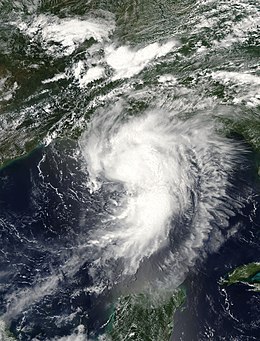Hurricane Cindy (2005)
| Category 1 hurricane (SSHWS/NWS) | |

Cindy shortly before being upgraded to a hurricane south of New Orleans on July 5
|
|
| Formed | July 3, 2005 |
|---|---|
| Dissipated | July 12, 2005 |
| (Extratropical after July 7) | |
| Highest winds |
1-minute sustained: 75 mph (120 km/h) |
| Lowest pressure | 991 mbar (hPa); 29.26 inHg |
| Fatalities | 1 direct, 4 indirect |
| Damage | $320 million (2005 USD) |
| Areas affected | Yucatán Peninsula, North Carolina, South Carolina, Alabama, Mississippi, Louisiana |
| Part of the 2005 Atlantic hurricane season | |
Hurricane Cindy was a tropical cyclone that briefly reached minimal hurricane strength in the Gulf of Mexico during July in the 2005 Atlantic hurricane season and made landfall in Louisiana. It was the third named storm and first hurricane of the season. Cindy was originally thought to have been a tropical storm at peak strength, but was upgraded to a Category 1 hurricane in the post-storm analysis. Cindy initially formed on July 3 just east of the Yucatán Peninsula in the Caribbean Sea. The depression soon made landfall on the peninsula and weakened before reemerging in the Gulf of Mexico on July 4. The storm strengthened as it moved north becoming a hurricane just before making landfall near Grand Isle, Louisiana, on July 5. The storm weakened as it moved overland and became extratropical on July 7.
The storm was responsible for 3 deaths in the United States and brought heavy rains to Louisiana, Mississippi, Alabama and Maryland. An unusually strong F2 tornado was spawned from Cindy's remnants and caused severe damage in Hampton, Georgia. Cindy also caused flooding and a severe blackout in New Orleans, Louisiana.
On June 24 a vigorous tropical wave moved off the African coast and quickly west across the Atlantic without developing. The wave gradually became more organized as it crossed the Caribbean and late on July 3 it strengthened into Tropical Depression Three about 80 miles (130 km) east of Chetumal, Mexico. The models initially had difficulty predicting the track of the depression and the forecasts from the National Hurricane Center reflected this, indicating that the depression would move towards Texas. The depression developed quickly before making landfall on Yucatán Peninsula early on July 4 with 35 mph (55 km/h) winds and began to lose its circulation overland. A new center of circulation began forming later on July 4, over the Gulf of Mexico, to the north of the original center. This reformation caused a significant alteration in the forecast models, which now indicated a landfall in Louisiana. The depression moved northwards into the Gulf of Mexico and became a tropical storm early on July 5, assigned the name Cindy.
...
Wikipedia
